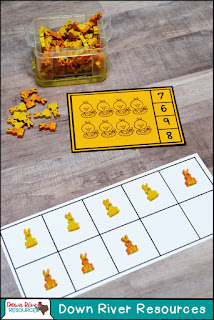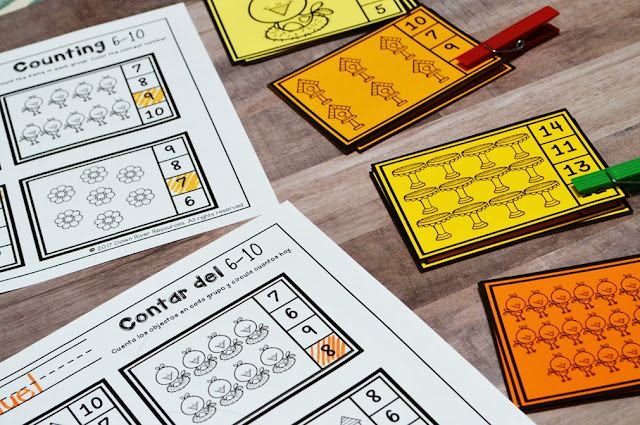Using Clip Cards in the Math Classroom
 Suggested Age Range for Activity
Suggested Age Range for Activity
Clip cards are best for early learners (pre-school through first grades.) Older students with a diverse range of learning abilities can also benefit from this hands-on math center.
Preparing for Activity
Clip cards are relatively easy to prep. First, print out the cards. Then, cut out the cards and laminate.
Teacher Tip: I always suggest laminating the cards for durability. If you are planning on using these as early or fast finisher activities or within a regularly visited math center, it is best to always laminate first. Otherwise, you will have stray marks on random cards that will drive you cRaZy! Trust me, friend. Even if you plan on using the cards once, it'll be worth it. You can use these cards for small groups, Guided Math, intervention time, or tutoring later. In addition, the weight of clothespins will bend the cards if they are not laminated.
To make the cards self-correcting, mark the correct answers with an adhesive dot on the back (yard sale sticker).
You can set them in a basket or bin and they're ready to go!
Ways to Maximize the Usage of Clip Cards
At first, students are just learning their numbers so this type of practice may be difficult. It also may come very easily to other students. It is important to maximize the use of any resource in the classroom, especially if your goal is to meet the needs of ALL of your students, especially those who need additionally support.
One thing I like best about clip cards is that I am able to use one set of cards and differentiate the activity type of segments of my students. I have several students who are struggling and need a lot of hands-on, tactile practice with manipulatives. I can use clip cards can benefit these students! On the other hand, I have students who are mastering the basic math skills and are ready for a challenge. Clip cards are also advantageous for these students as well.
Here are some of my go-to tools I use to maximize the usage of clip cards in my classroom:

Add a dry erase marker and board to the math center. Students can write a different way to represent the number on the dry erase board as an extension activity. Or, students can write the numeral for additional practice.
It is important for students to know how to represent whole numbers in various ways with and without picture and objects. This is a great activity to build this foundation of whole numbers.
One-to-one correspondence is when you match one object to one other object or person. You can practice this in various contexts but it is best to use a tactile method first. This is often why you see parents using their fingers while saying their numbers as it builds on this skill. A number doesn't mean anything if you do not know that it represents a quantity.
 Add a laminated ten frame to the center and that small bin of erasers to your math center. Students can practice building the number of the ten frame.
Add a laminated ten frame to the center and that small bin of erasers to your math center. Students can practice building the number of the ten frame.This extension allows students to practice applying the mathematical process standards to acquire and demonstrate mathematical thinking. Students are able to create and use representations to organize, record, and communicate mathematical ideas.
Students not allow build the number on the tens frame, but they can explain to their partner how they built the number. It is important that students know that when using a ten frame, they place objects one-by-one, from top to bottom and left to right.
Clip cards can be used in so many ways to benefit our students in the math classroom. They build students' number sense and fine motor skills. These cards are great for so students can acquire and demonstrate mathematical understanding.
I hope this post inspires you to use clip cards in your classroom and if you want to use my clip cards, they're in my TpT shop.
What are some other ways to use clip cards in your classroom?








No comments